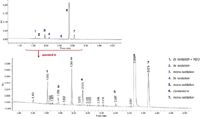A Quality by Design (QbD) Based Method Development for the Determination of Impurities in a Peroxide Degraded Sample of Ziprasidone
Waters Application Note
Introduction
Method development can be a time-consuming process that can be repeated many times thoughout a drug development pipeline. A systematic screening that evaluates a number of stationary phases, pH ranges and organic modifiers provides a thorough approach to method development. Incorporating Quality by Design (QbD) principles to this approach allows the use of a statistical Design of Experiments (DoE) to build-in robustness and define a 'design space', a region in which changes to method parameters will not significantly affect the results. The use of QbD provides a better understanding of method capabilities and limitations ensuring a greater chance of successful downstream method validation and transfer. Here, a QbD approach to method development is presented on a forced degradation sample of ziprasidone, an anti-psychotic drug. Method development was performed using an ACQUITY UPLC H-Class system running Empower 2 and Fusion AE Method Development software. The system was equipped with a six-position column manager and solvent select valve to allow for automated exploration of a wide range of conditions, while obtaining efficient separations with shorter chromatographic run times.
Results and Discussion
The initial screening experiment employed various column chemistries, including ACQUITY UPLC CSH C18, CSH Fluoro-Phenyl, BEH Shield RP18, HSS C18 SB, HSS T3 and HSS Cyano, to maximize selectivity. The organic modifier (acetonitrile or methanol) was screened varying the gradient endpoint from 50% to 100% organic, over a mobile phase pH range of 2.5–10.5. Using these parameters, an experimental design was generated within Fusion AE, including randomization and replicate injections. A partial factorial statistical design was selected by the software to obtain the maximum amount of information with the least number of experimental runs. The experimental design was transmitted to Empower 2 software where all methods, method sets and sample sets were automatically generated. Results from the screening analysis of ziprasidone were imported back into Fusion AE and processed to generate an initial method for subsequent optimization. For the ziprasidone peroxide degradation sample, a water/acetonitrile gradient at pH 2.5 with an 87.5% acetonitrile gradient endpoint on a CSH C18 column was found to be optimal.
This initial method was further optimized in a second experiment where secondary effectors such as column temperature, injection volume, gradient slope (modified using gradient time) and flow-rate were varied. After processing the results, the final optimized method was generated (Figure 1). Multi-dimensional plots in Fusion AE facilitate visualization of the effect of each factor on the separation. By changing the factors on each axis, the design space can be explored in detail and method robustness can be fully understood.

Figure 1: The separation of ziprasidone and impurities in a peroxide degradation sample from the final optimized method developed using QbD. The optimized method is on an ACQUITY UPLC CSH C18 2.1 à 50 mm, 1.7 µm column using a 0.1% formic acid in water (pH 2.5) and acetonitrile gradient, with UV detection at 254 nm. The gradient is from 0 to 87.5% acetonitrile over 8.5 min at a flow-rate of 0.8 mL/min. A column temperature of 30 °C and injection volume of 1 µL was found to be optimal.
Conclusions
A full, systematic method development experiment can be rapidly performed by combining fast separations using UPLC with efficient experimental designs by Fusion AE Method Development software. QbD method development software in conjunction with ACQUITY UPLC H-Class system automation allows for complete screening and optimization across a wide range of column chemistries, mobile phases and pH ranges, while evaluating the effects of secondary factors such as column temperature, flow-rate, injection volume and gradient slope on the separation. The comprehensive information gathered for a method developed using QbD principles generates a more robust method for downstream validation and can result in a higher quality submission for regulatory approval.
For full application, go to www.waters.com/qdb
©2011 Waters Corporation. Waters, The Science of What's Possible, ACQUITY UPLC, UPLC and Fusion are trademarks of Waters Corporation. Fusion is a trademark of S-Metrix.
Waters Corporation
34 Maple Street, Milford, Massachusetts 01757, USA
tel: +1 (508) 478-2000 fax: +1 (508) 478-1990
Website: http://www.waters.com

Separating Impurities from Oligonucleotides Using Supercritical Fluid Chromatography
February 21st 2025Supercritical fluid chromatography (SFC) has been optimized for the analysis of 5-, 10-, 15-, and 18-mer oligonucleotides (ONs) and evaluated for its effectiveness in separating impurities from ONs.



















